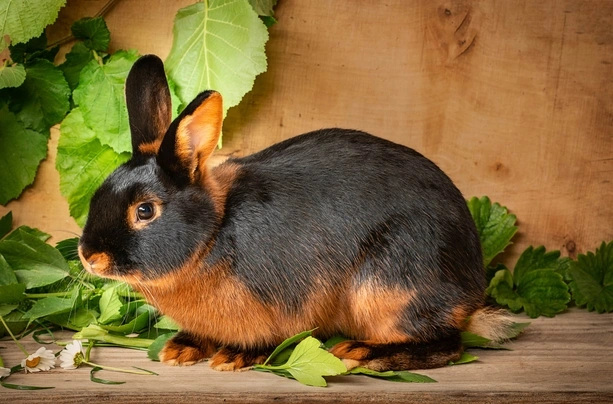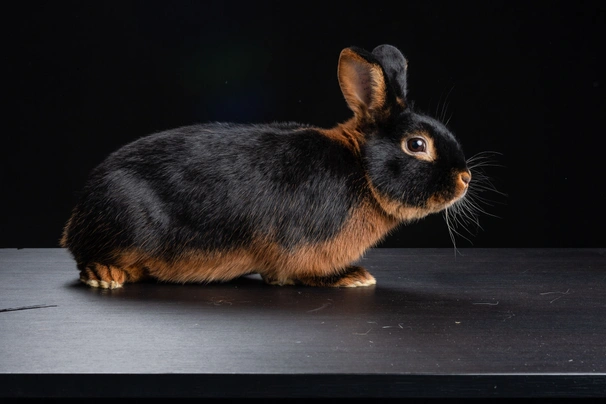Tan
Introduction of the Tan
A small breed of fancy rabbit, the Tan is bred and shown across the globe. Although it was originally developed in England, recently the breed has become very popular in America.
The breed comes in four accepted colourways: lilac, black, chocolate and blue. Adult Tans typically weigh between 4-6lbs.
History of the Tan
The Tan was initially bred in England, where it has been a regular visitor to shows since the late 19th Century. The first examples were bred in Derbyshire in around 1887 and were thought to be the result of crosses between the Dutch types and wild rabbits. The kits had very striking markings and were an instant hit with breeders, despite their incredibly bad tempers.
This ‘attitude problem’ made the Tan unsuitable as a companion, so the Belgian hare was introduced to the breed to give the body a more defined shape, increase the size and create a more even temperament.
Since the Belgian Hare was introduced selective breeding has been used to reduce the size of the Tan and fine-tune the colouration. The blue variety appeared in the early 20th Century, with the chocolate and lilac following later after the Havana was introduced into the lines.
Appearance of the Tan
- Main colourways: black, blue, chocolate and lilac
- Average weight: 4-6lbs
The original Tans were black. The coat was vibrant and lustrous and ticked with rusty orange. Following the adjustment of the temperament they quickly became very popular across the Continent and were in demand as pets.
As breeders experimented and crossed various lines, the dilute lilacs, chocolates and blues began to appear. These colours remain the only ones to be recognised by the American Rabbit Breeders Association (ARBA). The Tan has a well balanced, aerodynamic body and an alert appearance which reflects their curious and intelligent character.
The Tan Rabbit displays a beautiful and unusual sheen to its coat that’s not seen often in other rabbits and they are therefore highly sought after. Because of their unique appearance they are often referred to as ‘The Aristocrat of the Fancy’.
Temperament of the Tan
Because they have been selectively bred for temperament it’s rare to find a Tan that’s not sweet or intelligent. A lot of work has gone into ensuring they are friendly and pleasant to be around. However, this intensive selection for attractive character traits does not mean they make the perfect pet.
The Tan is a very active rabbit that requires lots of stimulation and exercise – more than his size would suggest, and this means he requires a knowledgeable, dedicated handler. They are not an affectionate, ‘lap’ rabbit.
Because they are still slowly regaining popularity finding a reputable Tan breeder may be difficult. It’s worth seeking out a good breeder however, as they can advise on appropriate care and will know the lines you are buying from are good ones.
Health of the Tan
As a smaller breed the Tan can be vulnerable to colds and viral infections. They should never be exposed to drafts or sudden changes in temperature and they should never be kept in a dusty or polluted atmosphere. Dust and pollution, as well as exacerbating any respiratory conditions, can also cause conjunctivitis. They are also prone to ear mites and coccidiosis, an internal parasite caused by unsanitary housing conditions.
As well as colds and viruses, dental issues are also common in rabbits. Their teeth grow constantly and need to be kept worn down with high fibre foods and gnaw toys. Any owner must keep an eye on their rabbit’s teeth. If they are allowed to overgrow they can cause difficulty in eating and injuries in the mouth that can lead to wounds and infection.
A rabbit that is overweight and cannot groom properly is susceptible to flystrike – particularly in warmer weather when lots of flies are present. The insects are attracted by soiled areas of fur, usually around the rear end, where they will lay their eggs. Maggots will then burrow into the rabbit’s skin and cause injuries which will require immediate veterinary attention.
All rabbits should be treated for worms, fleas and ticks and should be vaccinated against myxomatosis and Viral Haemorrhagic Disease (VHD), both of which are highly infectious and can be fatal.
Caring for the Tan
The Tan is a very active, energetic rabbit that will require lots of stimulation in the shape of games, training and outdoor exercise. They are, on the whole, sweet-natured animals, but will not enjoy cuddles and affection as much as other breeds. They would much rather be playing.
Because of their intelligence they will tolerate cats and dogs well and may suit indoor living better than being kept in a hutch. They will appreciate company and the freedom of living in a house, plus they will benefit from having people close by and numerous places to explore. They can also be easily trained to use a litter tray. They will investigate everything though, so anything important should be kept out of the way in order to stop him chewing. Cables and wires especially should be kept well out of his reach.
It’s vital that, if he’s going to be kept in a hutch, he has a rabbit friend to keep him company. He will quickly become bored if he doesn’t have something to keep him occupied. Any hutch must be completely weatherproof and positioned in a sheltered area and it must also be big enough to house two rabbits comfortably. It should be cleaned out thoroughly once a week, with droppings removed more regularly. Whether he lives indoors or out he should have the opportunity to exercise regularly. He can certainly exercise indoors, but he should also have regular access to the outdoors, either in a secure area of garden or a large run.
His diet should consist of good quality hay – Timothy hay is a good choice, as well fibrous green vegetables and rabbit pellets. Fresh, clean drinking water should also always be available.


